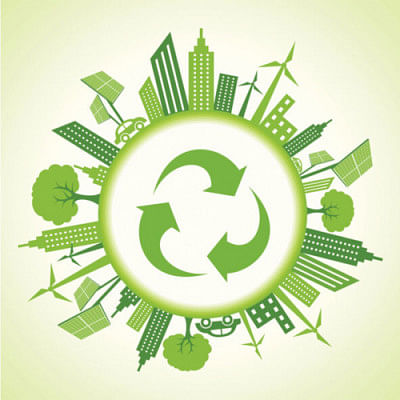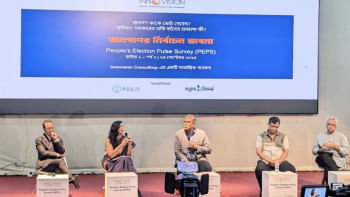Circular economy: A potential pathway to a sustainable Bangladesh

The circular economy has now become a buzzword across the world. The concept of a circular economy is a closed and regenerative economic model which is aimed at using and reusing resources as long as possible, keeping the environment in the forefront, whereas a traditional linear economy focuses on the creation, use and disposal of products and material. There is no existence of waste in the circular economy while in the traditional linear economic system, high levels of waste are generated through single-use products created for profit-making motives, ignoring all other social and environmental causes.
After a decade of progressive economic growth, Bangladesh is now moving towards developing country status by 2024. With this advancement, the country will need to compromise with the prevailing duty-free, quota-free market access to preferred markets. Undeniably, the future of exports will be a tough one if we are not adequately prepared to deal with this. Apart from this, the ongoing Covid-19 pandemic is shaping a new world economic order that can be presumed to be more complex, where tech-based and global competitiveness could be considered as one of the prime movers for growth and development. In this backdrop, the circular economy could be one of the sustainable economic models that can be used for reducing resource gaps and increasing sustainability in Bangladesh.
If we look at the potential of the circular economy in Bangladesh, its prospects are unquestionably immense. With a population of 165 million, this is the eight most populous and sixth most densely populated country in the world, with limited natural resources. According to Waste Atlas, Bangladesh's per capita waste generation is 149.7 kg per year. The post-harvest waste of vegetables and fruits is roughly 30 to 40 percent and food wastage is about 5.5 percent of total procured food, according to some studies. Wastage in daily life is not limited either. Our greenhouse gas emissions from industrial production processes, while much lower than in comparison to many other countries, can still also be reduced.
The circular economy can reduce the use of virgin raw materials and wastage, leading to positive impacts not only on the environment but also in terms of unexploited sources of useable materials, since it could possibly reduce the need for virgin raw materials. In order to create a sustainable circular economic model, a value chain must be created by adopting a digitally equipped process aligned with a better business model. As the prime focus is on using materials for as long as possible, more innovation is needed, including business model innovation. More technological adaption for the digitally equipped business system is also needed to shift from the traditional to the circular economy. Sustainability innovation is expected to create more jobs by turning waste into revenue streams, saving revenue through the use of innovative technologies and providing a new way to solve some of the biggest problems of our time, both locally and globally.
A giant global brand has recently adopted reusable and waste-free packaging in Europe as a test case for its products, such as shampoo, body lotion, toothpaste, deodorant etc, which can be returned to the brand and refilled in stores instead of turning into waste. This is a major leap forward, not only for businesses, but also for consumers and the future generations on a sustainable planet.
After graduating from Least Developed Country (LDC) status, in order to achieve our national targets and the Sustainable Development Goals (SDGs), Bangladesh should set out an action plan to make the best of the circular economic model. New and innovative business models need to be adopted to reuse products and make them more long-lasting. The redesign of the business model is crucial in this respect, but our key focus should be on turning our local waste into resources, and preventing our land from becoming a dumping ground for developing and developed nations in exchange for a very nominal incentive instead. If our policy allows the free flow of leftover products to the economy from abroad in the name of the circular model, that could be the worst case scenario.
Prudent circular economy management can help to achieve the SDGs by addressing a number of global issues including sanitation (SDG 6), climate action (SDG 13), sustainable cities and communities (SDG 11), life below water ( SDG 14) and responsible consumption and production (SDG 12). At the end of the day, the circular economy will help in reducing poverty and hunger (SDG 1 and 2), promoting good health and wellbeing (SDG 3) and fostering innovation (SDG 9) that leads to sustainable economic growth (SDG 8). For this, collective action (SDG 17) is required.
In order to adopt a large-scale circular economy, an open mindset is indubitably necessary to accept the changes that are in contrast with the built-in traditional and consumerist attitudes that currently exist. Thought leadership of relevant actors is crucial for greater acceptance of these new ideas. The private sector is the key driver of economic growth, which also drives the largest consumers of the resources of Bangladesh. Public and private co-operation is crucial to transform the challenges into opportunities at a national, regional as well as global level.
At the end of the day, a shift towards a circular economy is ultimately a call to understand Mother Nature and her limited resources, which is practically overlooked in our modern way of life. It is high time to readdress this resource gap by redesigning and re-engineering economic and business models in a resilient and sustainable way, keeping in mind that environmental and societal benefits must be a crucial part of our economic system.
Altap Hossen is an economic analyst, youth activist and adjunct faculty. Email: [email protected].

 For all latest news, follow The Daily Star's Google News channel.
For all latest news, follow The Daily Star's Google News channel. 



Comments